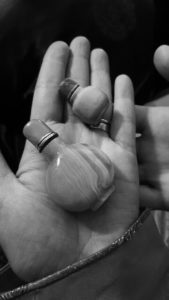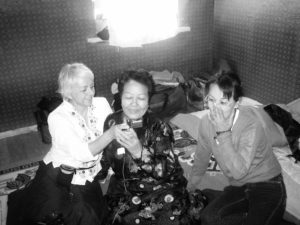
L to R: Tsagaanshuhert Munkhtsetseg , Jantsan Gundegmaa, Maruciya and Arildii Lhamsuren engaged in a traditional yet contemporary Mongol women’s exchange of their personal snuff bottles (in these instances, made of white jade and red coral) as a preliminary greeting ritual from which further dialogical exchanges will flow. Delgeruun Choira, Dundgovi, Mongolia. 12 August 2010. Photograph: C.Pleteshner
I have prepared this article for those of you who may be (non-nativist) scholars preparing to do interview-based qualitative research with contemporary Khalkha Mongol women who live in Mongolia. In 2008 I conducted such a series of thirty-four key informant interviews with Khalkha Mongol women in Mongolia (see Pleteshner 2011). This post to my blog outlines the development of two sets of (nativist) pseudonyms that supported that work.
Background
I developed data from each interview into a vignette. Each story in my own collection of vignettes is about a particular person. Vignette 01 Urantstetseg on this website is an example of this particular modality of research-based story telling. These are not fictitious characters. They are real women whom I have come to know not only through conducting a one-time face-to-face interview but through also sharing life experiences in Mongolia over many years before and after the face-to-face interviews were conducted.
I may be doing the ‘participant-observation’ narration, but I remind myself on a daily basis that it is they who are doing the real work of embodying and revitalising their local spiritual traditions after the cessation of soviet socialism now more than two decades ago. I am just a scribe who shapes their stories, in order to tell my own.

Mongol women’s personal snuff bottles made of red coral, hand-beaten silver and carved-polished agate (left) and one smaller, more modest in terms of both appearance and size (but not imbued value) that is made of stone (R). These and the oral narratives that accompany them are handed down from one generation to the next and are important in terms of both transmission and tradition. Delgeruun Choira, 27 February 2017. Photograph courtesy of A. Temuulen.
In my own writing, these women are introduced through pseudonyms. This authorial approach is necessary to protect their privacy in the greater public domain. Ironically, the main impetus for embarking on the Nomadic Temple project (the name of the book) with the women in the first place was to give them and their considerable generosity[i] towards the revival of the Gelugpa enterprise in Mongolia greater visibility. That was our intention. Some women in the study were expecting to see their own names in this stream of my research-based writing. Unfortunately they may have been disappointed. I am not a public-relations person or publicist. For me, ethical ethnographic research practices come first.
Onomastics
Mongolian ‘onomastics’ (the study of the origin and history of personal names) using ethnographic bibliographic survey methods and other literary sources is reasonably well researched (see Rybatzki 2007, p211). However, with the emphasis on ‘biographies containing eminent personalities’ (cf. to Middle Mongolian onomastics of the Mongol-Yuan period (1200-1300) the age of Chinggis Khan and the Mongol Empire), [ii] and with morphological structures aside, female personal names make up only a very small part of the entire corpus gleaned from indigenous sources: of 900 entries, only 50 of these are classified as female.
On closer examination, of these, 11 names can also be assigned to men. This leaves 39 names (around 4%) being attributed to women during this formative time in Mongol history. It is not surprising to find that although morphological structures (ie specific structural features) and the semantics (the branch of linguistics concerned with meaning) of the names against Mongolian and Turkic backgrounds is considered, the women whose names have been recorded are relational: ‘the mother’, ‘the mother in law’, ‘given as … the (principal/secondary) wife’, ‘one of two wives’, a (first) daughter’, ‘lady of high rank’ of the Mongol nobility, etcetera.
Attuning
In my ethnographic writing, there is an ever-present tension in relation to an imagined audience; particularly when one has elected to publish in the public domain. I feel a deep sense of obligation to take with me the Mongol women around whom my own narratives have been shaped and are formed. They are important others for whom I primarily write.
One of the more straightforward technical solutions I found to bring into accord this tension, was to select Mongolian pseudonyms that are in sympathetic relationship with the actual women whom they are intended to represent. And so the next qualitative research micro-methodological question arises: how does one systematize the selection of 21 (then another 21, for why 21 see below) suitable Mongolian pseudonyms from an otherwise limitless range of options?

L to R: CP, Maruciya (her real name and one of the Mongol women I interviewed for the study) and her niece, a relative- observer for the purposes of transparency) looking at the recording of Maruciya’s interview just completed. Maruciya, although Mongolian has a Russian name— but this additional layer of social complexity can be the subject of another post. A foreigner (CP) taking interest in, and recording their stories was a first for all 34 Khalkha Mongol women in the study. Delgeruun Choira, the Dundgovi, Mongolia. 25 August 2008. Photograph courtesy of D.Gerlee.
What’s in a number?
The number ‘21’ is no random selection. The twenty-one Taras have deep cultural and personal connections. The decision to initially identify a set of 21 names by which Mongolian women were to be represented was the outcome of my desire to link my own studies about Mongolian Buddhist women to the well-known twenty-one Taras of the Mongol Gelugpa Buddhist pantheon.[iii] A consideration, in one way or another, of ‘Mother Tara’ is an aspect of their relational being that the women in my study had in common. These are inner and manifest relationships they have been explicitly (not implicitly) expressed to me in various ways.
When I initially embarked on a more formal and systematic approach to my study of Mongol culture in Mongolia, after having already spent four years ‘in the field’, more and more Mongolian women in the community began coming forward to contribute to my work, so the need for even more names (i.e. pseudonyms) than the initial twenty-one spontaneously arose.
What’s in a name?
To meet this need, we (the small group of Khalkha Mongol women with whom I was collaborating and I) compiled two sets of 21 pseudonyms for this particular research project: those with the suffix ‘-maa’, and those with the suffix ‘-tsetseg.’
When ‘we’ initially started compiling the list of pseudonyms we tried to assemble a list of names made up of only two syllables. The initial list of 15 names soon became shorter than the study now required as more and more women stepped forward to add their voice.
By adding the dimension of precious stones, we were able to come up with more Mongolian names to be used as pseudonyms. But in retaining an emphasis on communicating different ‘qualities of mother’ and ‘flowerings’, something the Mongol women considered important, Mongolian names of 3 to 4 syllables in length were included.
Non-nativist English language authors and readers may struggle to overcome the ‘language barrier’ that such multi-syllabic names present. However, I encourage perseverence. It seems inappropriate for anything other than such names (as pseudonyms) that are Mongolian to be used in narratives about these Mongolian people and their culture. If the benchmark is to find a solution that fits well with nativist Mongol practice then this is the closest solution I could find.
In Mongolia, a name is never just a name
From my own field work (2004-2017) I have come to deeply appreciate the importance of symbolic (cf. representative of personal disposition) namings of Khalkha Mongol women’s newborn by their nominated Gelugpa prelates, past and present. The women have spoken of it directly, and refer to it in passing. The import, and scheduling of this ritual in their social circles goes without question. The main problem they seemed to be having was scheduling the date with their preferred Mongolian prelate; someone who was (as usual) very busy either locally or abroad. Without a set date on which the naming ceremony was to be performed, and before the baby was too old, no further arrangements regarding the associated family gathering could be made.
If my understandings of their stories for my cross-cultural illumination and benefit are correct, then such a naming by a Buddhist prelate signifies (to them) particular qualities, pre-dispositions of being and aspects of the newly born’s character that will emerge, and that are to be cultivated over time. In terms of method, from the mothers in question, it is not simply a matter of selecting from a collated short list of Mongol names here.
Namings (received from Mongol Gelug prelates) are also seen as reflections of the newborn’s previous lives. Mongol names, some of which are syncretic adaptations of names of deities drawn from a Mongol-Tibetan Buddhist pantheon, are seen to refer (in the distributed heart-mind of the kinship group) to potential (if not yet actualized) aspects of the newborn’s character and temperament.
I struggle when I try to put into written words for non-proximal outsiders descriptions of such things. Nonetheless, as one aspect of developing an appropriate strategy for interview-based expositional purposes, the adoption of such pseudonyms brings a degree of anonymity. Their use can also play an important role in what Pranee Liamputtong (2010, p40) refers to as the ‘cause no harm’ principle, given that individual patronymics (although known) have also been removed.
Two sets of Twenty-One Mongol Women’s names
Below are two lists of Khalkha Mongol women’s pseudonyms: those with the suffix ‘—maa’ and those ending in ‘—tsetseg’. Names such as these are often given to newborn children of Mongol Buddhist women by the parents’ nominated prelate, spiritual teacher or a monk. The names in these two groupings are by no means unusual in Mongolia, hence their selection and adoption as pseudonyms here.
These two collections of Khlakha Mongol names and their attributed (cultural) meanings were compiled in consultation with a reference group of contemporary Mongol women in Mongolia in two locations: in metropolitan UB and in Delgeruun Choira in the Dundgovi. The translation of each pseudonym is a cross-cultural ‘negotiated text’ (see Denzin and Lincoln 2003).
A list of Twenty-One Khalkha Mongol Women’s names with the suffix ‘ maa’
The following names are considered by women to be associated with ‘qualities of mother’. The suffix ‘maa’ is also used to signify the feminine in the Tibetan language. It does not have the same function in the Mongolian language. An attributed meaning for each Mongolian name has been noted.
| Mongolian name
(with maa suffix) |
Meaning
(attributed) |
|
| 1 | Suvdmaa | pearl mother |
| 2 | Altmaa | golden mother |
| 3 | Mungumaa | silver mother |
| 4 | Boldmaa | steel mother |
| 5 | Oyumaa | emerald/turquoise mother |
| 6 | Batmaa | strong mother |
| 7 | Enkhmaa | healthy mother |
| 8 | Munkhmaa | everlasting/eternal mother |
| 9 | Ochmaa | flame mother |
| 10 | Odmaa | star mother |
| 11 | Tuulmaa | mother of the River Tuul * |
| 12 | Baljmaa | mother of the River Balj |
| 13 | Sodmaa | unique mother |
| 14 | Soyolmaa | cultural mother |
| 15 | Handmaa | goddess mother |
| 16 | Bayarmaa | happiness mother |
| 17 | Burmaa | sweet mother |
| 18 | Dulmaa | Tara mother |
| 19 | Galtmaa | fire mother |
| 20 | Tsermaa | long life mother |
| 21 | Suheemaa | mother strong like an axe |
* Taken after the name of the river, by whose waters a newly born baby’s body is first washed.
A list of Twenty-One Khalkha Mongol Women’s names with the suffix ‘ tsetseg’
In Mongolian culture, names with this suffix are identified with flowers and qualities associated with precious stones. According to Rybatzki (2007, p217) the Khalkha ‘ceceg’ for flower—rendered as tsetseg, the suffix used to construct many of the Mongol pseudonyms in this work—is a loanword from the Uighur (Turkic ethnic group) ‘cecek’ for flower. An attributed meaning for each Mongolian name has been noted.
| Mongolian Name
(with tsetseg suffix) |
Meaning
(attributed) |
|
| 1 | Gantsetseg | flower of steel |
| 2 | Enkhtsetseg | flower of health/ healthy flower |
| 3 | Battsetseg | strong flower |
| 4 | Sodtsetseg | unique flower |
| 5 | Zultsetseg | flower of butter lamps |
| 6 | Bertsetseg | flower like a bride |
| 7 | Saintsetseg | pleasant flower |
| 8 | Narantsetseg | Sun flower |
| 9 | Sarantsetseg | Moon flower |
| 10 | Shurentsetseg | coral flower |
| 11 | Munguntsetseg | silver flower |
| 12 | Bolortsetseg | crystal flower |
| 13 | Suvdtsetseg | pearl flower |
| 14 | Nomintsetseg | turquoise flower |
| 15 | Oyuntsetseg | emerald flower |
| 16 | Ariuntsetseg | holy flower |
| 17 | Bayartsetseg | flower for happiness |
| 18 | Sarnaitsetseg | rose flower |
| 19 | Gereltsetseg | flower of lights |
| 20 | Urantsetseg | eloquent flower |
| 21 | Buyantsetseg | wealthy flower |
Attribution
In keeping with ethical research and publishing practices, and the Creative Commons Attribution 4.0 International License, I would expect that anyone replicating, or translating into another language, all or part of the above previously unpublished schematic information under their own name to cite my work as the source.

Building on data I began collecting in 2004, in 2008 with Damdin Gerlee’s assistance (pictured above) I conducted a series of interviews in the capital as well as in the countryside with Mongolian women involved in the reconstruction of contemporary Mongol Gelug Buddhism after the cessation of the soviet socialist era. These recorded conversations were then carefully transcribed and translated into English. It was Gerlee who did this and other important ‘first cut’ transcription work. Ulaanbaatar, Mongolia. 8 September 2008. Photo: C.Pleteshner
Footnotes
[i] I use the term ‘generosity’ throughout my own writings. It carries with it various associations, including a readiness to give, freedom from meanness or smallness of mind or character, and at times nobleness; admirable in dignity of conception, manner of expression, being, or composition. For serious practitioners of Gelug Buddhism, generosity as compared with ‘idiot compassion’ is one of the perfections, and is to be cultivated. In my experience, doing so is not as straight forward as it may first appear. See Chapters 9 of The Perfection of Generosity and Chapter 10, How to Give in Je Tsongkhapa’s The Great Treatise on the Stages of the Path to Enlightenment (Byang chub lam rim che ba) (Cutler and Newland 2004).
[ii] See: http://www.silk-road.com/newsletter/volumeonenumberone/age.html. Retrieved: 14 February 2017.
[iii] See Wilson (1996) Beyer (1978) Jo Nang Tarantha & Templeman (1995) Shaw (2006) and Landsman (2008).
References
Beyer, Stephen. 1978. The Cult of Tara: magic and ritual in Tibet. Berkeley: University of California Press.
Cutler, Joshua W. C. , and Guy Newland, eds. 2004. The Great Treatise on the Stages of the Path to Enlightenment by Tsong-kha-pa. 1 ed. 3 vols. Vol. 2. Ithaca, New York: Snow Lion Publications.
Denzin, Norman K, and Yvonne S Lincoln. 2003. The Landscape of Qualitative Research: theories and issues. Edited by The Landscape of Qualitative Research, Norman K Denzin and Yvonne S Lincoln. 2nd ed. Thousand Oaks, California: Sage Publications.
Jo Nang Taranatha (David Templeman trans.). 1995. The Origin of Tara Tantra. (Tib. sgrol ma’i rgyud kyi byung khung gsal bar byed pa’i lo rgyus gser gyi phreng ba zhes bya ba) Dharamsala: Library of Tibetan Works & Archives. Original edition, 1981.
Landesman, Susan S. 2008. “Goddess Tārā: Silence and Secrecy on the Path to Enlightenment.” Journal of Feminist Studies in Religion 24 (1):44-59.
Liamputtong, Pranee. 2010. Performing Qualitative Cross-Cultural Research. New York: Cambridge University Press.
Pleteshner, Catherine. 2011. Nomadic Temple: Daughters of Tsongkhapa in Mongolia. Melbourne, Australia: self published. pp75-77 and pp. 362-363.
Rybatzki, Volker. 2007. “Female Personal Names in Middle Mongolian Sources.” In The Role of Women in the Altaic World (Permanent International Altaistic Conference 44th Meeting, Walberberg, 26-31 August 2001), edited by Veronica Veit, 211-230. Wiesbaden: Harrossowitz Verlag.
Shaw, Miranda. 2006. “Tara: Mahayana Buddha Universal Savior.” In Buddhist Goddesses of India. Oxford: Princeton University Press. pp306-54.
Wilson, Martin. 1996. In Praise of Tara: songs to the Saviouress. 2nd ed. Boston: Wisdom Publications.
end of transcript.
This article Vignette 06: What’s in a name? was researched and written by Catherine Pleteshner.
Refer to the INDEX for other articles that may be of interest.
© 2013-2025. CP in Mongolia. This post is licensed under the Creative Commons Attribution 4.0 International License. Documents linked from this page may be subject to other restrictions. Posted: 16 February 2017. Last updated: 21 April 2019.